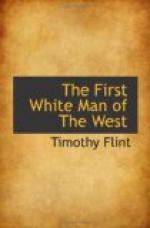In periods of alarm a trusty sentinel on the roof of the building was so stationed, as to be able to descry every suspicious object while yet in the distance. The gates were always firmly barred by night; and sentinels took their alternate watch, and relieved each other until morning. Nothing in the line of fortification can be imagined more easy of construction, or a more effectual protection against a savage enemy, than this simple erection. Though the balls of the smallest dimensions of cannon would have swept them away with ease, they were proof against the Indian rifle, patience, and skill. The only expedient of the red men was to dig under them and undermine them, or destroy them by fire; and even this could not be done without exposing them to the rifles of the flankers. Of course, there are few recorded instances of their having been taken, when defended by a garrison, guided by such men as Daniel Boone.
Their regular form, and their show of security, rendered these walled cities in the central wilderness delightful spectacles in the eye of immigrants who had come two hundred leagues without seeing a human habitation. Around the interior of these walls the habitations of the immigrants arose, and the remainder of the surface was a clean-turfed area for wrestling and dancing, and the vigorous and athletic amusements of the olden time. It is questionable if heartier dinners and profounder sleep and more exhilarating balls and parties fall to the lot of their descendants, who ride in coaches and dwell in mansions. Venison and wild turkeys, sweet potatoes and pies, smoked on their table; and persimmon and maple beer, stood them well instead of the poisonous whisky of their children.
The community, of course, passed their social evenings together; and while the fire blazed bright within the secure square, the far howl of wolves, or even the distant war-whoop of the savages, sounded in the ear of the tranquil in-dwellers like the driving storm pouring on the sheltering roof above the head of the traveller safely reposing in his bed; that is, brought the contrast of comfort and security with more home-felt influence to their bosom.
Such a station was Bryant’s, no longer ago than 1782. It was the nucleus of the settlements of that rich and delightful country, of which at present Lexington is the centre. There were but two others of any importance, at this time north of Kentucky river. It was more open to attack than any other in the country. The Miami on the north, and the Licking on the south of the Ohio, were long canals, which floated the Indian canoes from the northern hive of the savages, between the lakes and the Ohio, directly to its vicinity.




